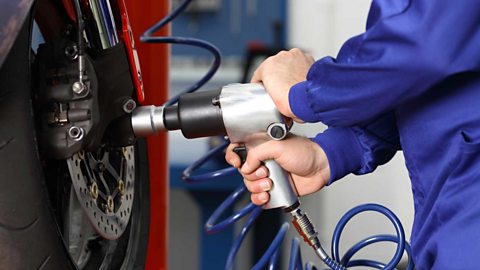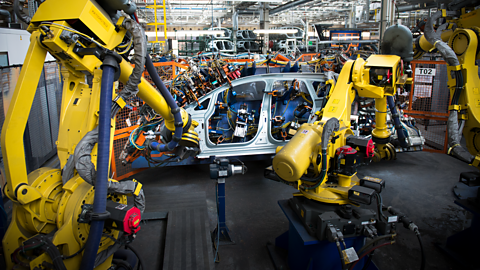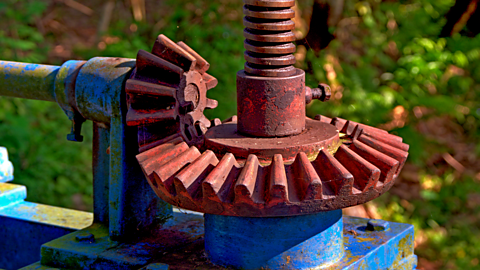Key points
- levers use mechanical advantage to make lifting or applying pressure easier
- the three main parts of a lever are the effort (input force), fulcrum (pivot point), and load (output force)
- there are three classes of levers, each arranging the effort, fulcrum, and load differently to maximise mechanical advantage
- mechanical advantage is the ratio of the load to the effort, showing how much easier a lever makes lifting a load
- it is measured by dividing the load by the effort applied to moving it: mechanical advantage = load (N) ÷ effort (N)
How to calculate mechanical advantage
Mechanical advantage is the amount of help you get using a machine in comparison to moving something with just human effort, and it is created by levers.
It is measured by dividing the load by the effort applied to moving it, both measured in Newtons (N) - this could also be described as the output (load) divided by the input (effort):
mechanical advantage - load (N) ÷ effort (N)
Example
A person lifting a load of 200 N but only using 100 N of effort:
Therefore, the mechanical advantage = 200 ÷ 100 = 2.This can also be written as 2:1. The person is able to lift twice the load using 100 N of effort.
- mechanical advantage = load ÷ effort
- load = mechanical advantage × effort
- effort = load ÷ mechanical advantage
What is the moment of a lever?
A moment is the turning effect of a force applied at a distance from a pivot point (fulcrum). It determines how effectively a force can cause an object to rotate around a pivot point.
Moments are crucial in understanding how levers work. By calculating moments, you can determine how much force is needed to lift a load or how the position of the fulcrum affects the lever's efficiency.
Moments act about a pivot in a clockwise or anticlockwise direction.
Now to calculate the moment of a force
The size of the moment of a force can be calculated using the equation:
moment of a force = force (F) x perpendicular distance from the pivot (d)
moment = F x d
- force F is measured in newtons (N)
- distance d is measured in metres (m)
- moment is measured in newton metres (Nm)
perpendicular distanceThe distance from the pivot which makes a right angle with the line of action of the force. from pivot to force d = 0.50m.
Force F = 10 N
Moment = F x d
Moment = 10 N x 0.50m
Moment = 5 Nm
This is a clockwise moment.The force will rotate the object in a clockwise direction about the pivot.
Calculate the moment
A force of 15 N is applied to a door handle, 12 cm from the hinge.
Calculate the moment of the force.
Answer:
Perpendicular distance from pivot to force d = 12cm or 0.12m.
Turning force F = 15 N
Moment = F x d
Moment = 15 N x 0.12m
Moment = 1.8 Nm.
The moment of the force is 1.8 Nm
How to calculate efficiency in levers
Efficiency in levers refers to how effectively they convert input work into output work. Due to factors like friction at the fulcrum, some energy is always lost, and no lever is 100% efficient.
Formula
\( \text{Efficiency(\%)} = (\frac{\text{mechanical advantage}}{\text{velocity ratio}}) \times 100\)
Understanding the components:
- mechanical ddvantage (MA): the ratio of the load to the effort
- velocity ratio (VR): the ratio of the distance moved by the effort to the distance moved by the load
Example:
A lever lifts a 300N load with an effort of 100N. The effort moves 20cm to lift the load by 5cm.
- Mechanical Advantage = Load / Effort
- = 300N / 100N
- = 3
- Velocity Ratio = Distance moved by effort / Distance moved by load
- = 20cm / 5cm
- = 4
- Efficiency = (MA / VR) x 100
- = (3 / 4) x 100
- = 75%
Calculate the velocity ratio and the efficiency of a lever
A lever with a mechanical advantage of 4 and lifts the load 6cm. The effort applied to the lever moves 30cm.
- calculate the velocity ratio of the lever.
- calculate the efficiency of the lever.
Answer:
Velocity Ratio = Distance moved by effort / Distance moved by load
- = 30cm / 6cm
- = 5
Efficiency = (MA / VR) x 100
- = (4 / 5) x 100
- = 80%
What are linkages?
Levers can be joined together to form linkages. Simple linkages change the direction of motion and the amount of force.
What is a bell crank?
- a bell crank is a type of lever that changes the direction of force by 90 degrees.
- the amount of output force can be changed by moving the fixed pivot
- when used in bicycle brakes, the rider can pull the brakes from the handlebars, which changes direction through the bell crank to make the brake pads touch the wheels.
What are parallel linkages
- parallel motion linkages or push/pull linkages use two fixed pivots to make the input and output travel in the same direction, through a link arm.
- each fixed pivot has a moving pivot on either side, allowing the movement and power to go backwards and forwards.
- changing the placing of the fixed pivots changes the amount of force exerted, while keeping the direction the same. For example, a toolbox with drawers opens effectively using parallel motion linkages.
Test yourself
More on Mechanical and pneumatic control systems
Find out more by working through a topic
- count6 of 7

- count7 of 7

- count2 of 7
